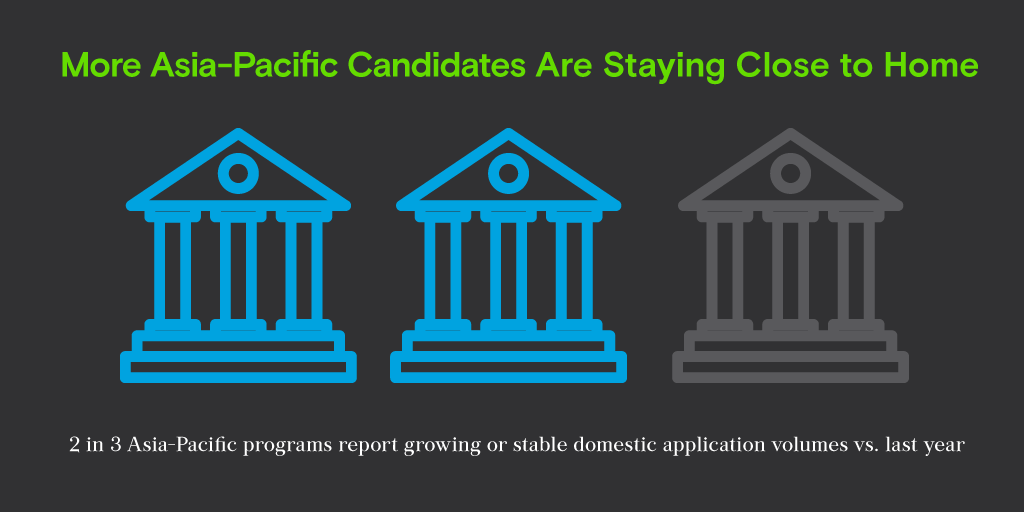Now available as a recording, last week’s webinar broke down the current state of the market for Asia-Pacific programs.

On November 13, GMAC Research digitally hosted business school professionals from leading institutions across the Asia-Pacific region for the Asia-Pacific Application Trends Survey 2019. Based on the findings detailed in our Application Trends Survey Report 2019, the 30-minute presentation discussed global demand for GME and did a deep dive into the state of the market for Asia-Pacific programs. The webinar recording, slides, and transcript are now available to school professionals in the gmac.com Research Library (requires login).
Here’s a quick recap of what we covered:
Global Demand for GME
Though total applications to graduate management education (GME) programs declined slightly year-on-year (-3.1%), global GME remains selective, programs continue to seat classes with highly-qualified talent, business school graduates continue to be in-demand with employers, and alumni express high levels of satisfaction.
For instance, 8 in 10 Asia Pacific employers agree that business school graduates are well prepared to be successful in their company and 9 in 10 plans to hire MBA talent this year, which is higher than any other world region. Nine in 10 alumni agree that their GME was personally and professionally rewarding and would still pursue their degree again knowing what they know now.
International Student Mobility
Ongoing mobility shifts continued to take hold in the market this year. A growing number of Asia-Pacific candidates opted to stay either in-country or in-region, and internationally-minded candidates sent more applications to Europe and Canada and fewer to the United States.
Between 2017 and the first half of 2019, the percentage of Asia-Pacific business school candidates that planned to apply to an Asia-Pacific business school increased from 41 percent to 47 percent, and over the same period the percentage who said their preferred study destination was in Asia Pacific grew from 24 percent to 29 percent. Why? For one, there are more high-quality business school options in Asia Pacific than ever before. In the year 2000, for example, Asia Pacific business schools weren’t represented at all in the Financial Times ranking of global MBA programs. This year, 12 Asia Pacific programs cracked the top 50. In addition, candidates are seeking to improve access to jobs in their home countries, where is many cases there is very strong economic growth and ample opportunity for business school graduates.

Asia-Pacific Deep Dive
The overarching theme to the findings for Asia-Pacific programs this year is that application volumes were largely up on the strength of domestic demand this year, though the growth has slowed somewhat compared with the last two years.
For instance, this year a greater proportion of Asia-Pacific programs overall report total application growth (49%) than declines (45%), however the percentage of Asia-Pacific programs reporting total application growth declined for the second consecutive year from a high of 72 percent in 2017.
What’s chiefly driving the growth for Asia-Pacific programs is domestic applications. This year, 2 in 3 programs report that they received more domestic applications this year than last year. Similar to past years, applicant pools to Asia Pacific programs were largely domestic or from within the region. On average, Asia-Pacific programs report that 55 percent of their applications come from domestic talent, and 90 percent of applications come from within the Asia-Pacific region.
Making the Most of Your Participation
To round out the presentation, we reviewed how school professionals in Asia-Pacific can get the most out of their programs’ survey participation by leveraging two data tools made available exclusively to participating programs:
- The data report provides users with the ability to explore and filter the survey data by program type, world region, and program start date
- The benchmark report allows users to compare your program with five or more other programs that responded to the survey
All participating programs received a custom link to these tools via email from research@gmac.com. If you need your program’s link resent, please send us an email.
For more on the Application Trends Survey, visit gmac.com/applicationtrends to access the 2019 report and the infographic series, including the Asia-Pacific infographic.


